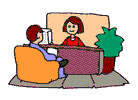Email Etiquette
The Internet and email are now almost as common as the old Bell telephone used to be to communicate with the people in our lives. It is incredibly important to remember some key etiquette rules when sending and receiving email.
 Be courteous. Make sure your emails begin with the individual’s name to whom you are writing, and end with a salutation and your name. A “safe” salutation is “Regards”. No matter how well you know the individual to whom you are emailing, it is important to observe these rules when emailing.
Be courteous. Make sure your emails begin with the individual’s name to whom you are writing, and end with a salutation and your name. A “safe” salutation is “Regards”. No matter how well you know the individual to whom you are emailing, it is important to observe these rules when emailing.
DON’T USE ALL CAPS. Caps make the receiver believe you are shouting. CAPS should only be used for emphasis within a sentence, NOT for the entire sentence.
Use short paragraphs. A paragraph should only contain 3 lines, or 17 to 20 words. This makes for easier reading for your recipient, and will help you keep your thoughts organized as you write.
Remember your recipient. If you have something very important to communicate, don’t use email. You don’t know what mood or kind of day the person receiving your email may be having, so don’t use email to vent or to communicate negative thoughts or feelings. Pick up the phone or better yet, go see that individual in person.
Have a purpose. Email can be effective when communicating short, meaningful messages. Don’t send out short novels to individuals; they don’t have time to read them, and your email will end up in the “delete” box. Don’t use more than 2 font colors. Emails are difficult enough to read if you are a “visual” person. Color is great for emphasis on important items, but using more than 2 font colors will easily tire the eyes and will deter your recipient from wanting to read further.
Use “Plain Text” language. While “Rich Text” can be fun, and can allow you to incorporate smiley faces and other points of emphasis, most recipients (especially at work) will only be able to receive Plain Text emails.
Attachments. When you need to send an email with extensive information, use Word or Excel file attachments. The recipient will then be able to open the attachments at their leisure and ready them more easily.
Subject Line. Every email should have a specific subject line. With all the SPAM and other marketing emails that flood one’s inbox, it is critical that your subject be specific to the content of your email. This will enable your recipient to know quickly what is contained within the email, and will help them manage their email effectively.
Reading emails. If you use email for work purposes, one way to effectively manage your time is to designate certain times of the day to read and respond to emails. This will help you stay focused on quick responses and concise emails.
Overall, email is a very important form of the 10 different methods of communication. Using it wisely will ensure your recipients read and respond to your emails timely and concisely.